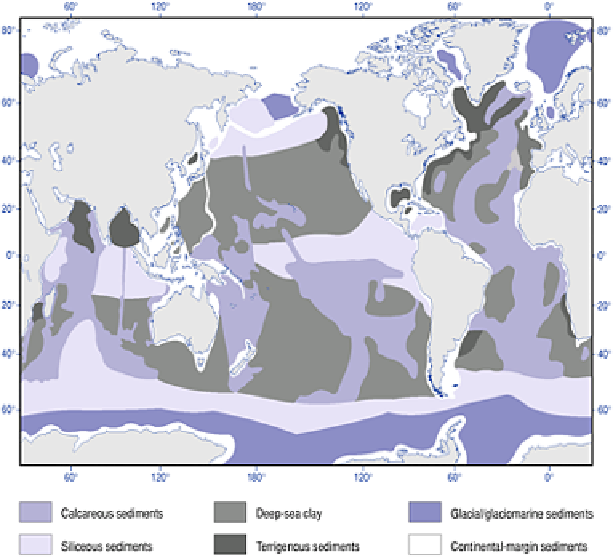Environmental Engineering Reference
In-Depth Information
Figure 12.18
Global distribution of sea-floor sediments.
Source: After Reading (1996).
chalk represent former Laurasian and Tethys carbonate oceans in the geological record.
Hydrothermal circulation adds a suite of
hydrogenic
sea-bed sediments which become
buried by younger sediments as they rift away from their mid-ocean ridge source.
Manganese (Mn) nodules are widespread and of increasing resource potential for,
additionally, Fe, Cu, Co and Ni.
This relatively simple arrangement becomes complicated by intercalation or lateral
intergrowth of different sediment bodies through sea-level change, episodic sediment
supply and the rain-out of
red clays
and
glaciomarine sediments
. The former are iron
oxide-coated mixes of clay minerals from terrigenous sources carried far into the ocean
by suspension in sea water, or atmospheric plumes of fine volcanic ash or desert dust, and
biogenic material. Glaciomarine deposition is restricted by the fluctuating survival range
of icebergs or grounded marine glaciers during Quaternary cold and temperate stages.
Sediments are decanted as icebergs melt, or emerge from
tidewater glaciers
as waterlain
till, or as powerful plumes forming extensive
mud drapes
(see Chapter 15). The Yakataga
formation, in the Gulf of Alaska, is a spectacular example of ocean-glacier- tectonic
interaction. Pacific Plate subduction and continental plate elevation have caused a vertical
accretion of 5 km of Plio-Pleistocene glaciomarine sediments in the coast ranges.
With these sediment sources and characters in mind, we can now consider their
depositional environments (Figure 12.19). Shallow-water continental shelves are

